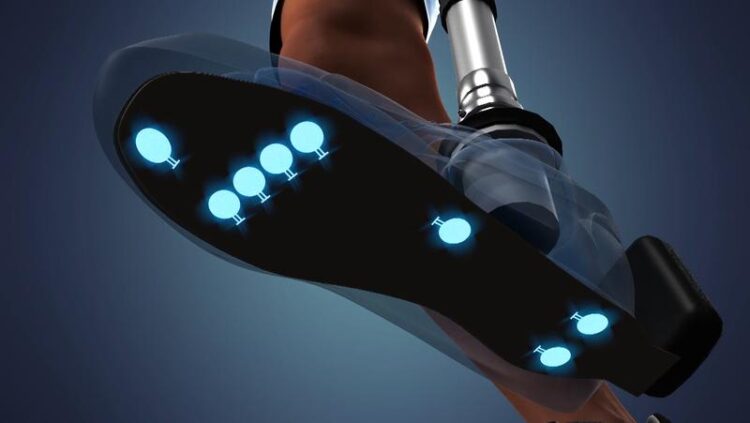Perceiving prosthesis as lighter thanks to neurofeedback

Signals from tactile sensors under the sole of the prosthetic foot and from angle sensors in the electronic prosthetic knee joint are passed on to the nervous system. (Visualisations: ETH Zurich)
Transmitting sensory signals from prostheses to the nervous system helps leg amputees to perceive prosthesis as part of their body. While amputees generally perceive their prostheses as heavy, this feedback helps them to perceive the prostheses as significantly lighter, ETH researchers have shown.
Leg amputees are often not satisfied with their prosthesis, even though the sophisticated prostheses are becoming available. One important reason for this is that they perceive the weight of the prosthesis as too high, despite the fact that prosthetic legs are usually less than half the weight of a natural limb. Researchers led by Stanisa Raspopovic, a professor at the Department of Health Sciences and Technology, have now been able to show that connecting the prostheses to the nervous system helps amputees to perceive the prosthesis weight as lower, which is beneficial for their acceptance.
Together with an international consortium, Raspopovic has developed in recent years prostheses that provide feedback to the wearer’s nervous system. This is done via electrodes implanted in the thigh, which are connected to the leg nerves present there. Information from tactile sensors under the sole of the prosthetic foot and from angle sensors in the electronic prosthetic knee joint are converted into pulses of current and passed in to the nerves.
“To trick an above-knee amputee’s brain into the belief that the prosthetic leg was similar to his own leg, we artificially restored the lost sensory feedback,” says ETH professor Raspopovic. In a study published last year, he and his team showed that wearers of such neurofeedback prostheses can move more safely and with less effort.
Beneficial involvement
In a further study, the scientists were now able to show that neurofeedback also reduces the perceived weight of the prosthesis. They published the results in the journal Current Biology.
In order to determine how heavy a transfemoral amputee perceives their prosthetic leg to be, they had a voluntary study participant complete gait exercises with either neurofeedback switched on or off. They weighed down the healthy foot with additional weights and asked the study participant to rate how heavy he felt the two legs were in relation to each other. Neurofeedback was found to reduce the perceived weight of the prosthesis by 23 percent, or almost 500 grams.
The scientists also confirmed a beneficial involvement of the brain by a motor-cognitive task, during which the volunteer had to spell backwards five-letter words while walking. The sensory feedback not only allowed him to have a faster gait but also to have a higher spelling accuracy.
“Neurofeedback not only enables faster and safer walking and positively influences weight perception,” says Raspopovic. “Our results also suggest that, quite fundamentally, it can take the experience of patients with an artificial device closer to that with a natural limb.”
Reference
Preatoni G, Valle G, Petrini FM, Raspopovic S: Lightening the perceived prosthesis weight with neural embodiment promoted by sensory feedback. Current Biology, 7 January 2021, doi: 10.1016/j.cub.2020.11.069
Media Contact
All latest news from the category: Medical Engineering
The development of medical equipment, products and technical procedures is characterized by high research and development costs in a variety of fields related to the study of human medicine.
innovations-report provides informative and stimulating reports and articles on topics ranging from imaging processes, cell and tissue techniques, optical techniques, implants, orthopedic aids, clinical and medical office equipment, dialysis systems and x-ray/radiation monitoring devices to endoscopy, ultrasound, surgical techniques, and dental materials.
Newest articles

Innovative 3D printed scaffolds offer new hope for bone healing
Researchers at the Institute for Bioengineering of Catalonia have developed novel 3D printed PLA-CaP scaffolds that promote blood vessel formation, ensuring better healing and regeneration of bone tissue. Bone is…

The surprising role of gut infection in Alzheimer’s disease
ASU- and Banner Alzheimer’s Institute-led study implicates link between a common virus and the disease, which travels from the gut to the brain and may be a target for antiviral…

Molecular gardening: New enzymes discovered for protein modification pruning
How deubiquitinases USP53 and USP54 cleave long polyubiquitin chains and how the former is linked to liver disease in children. Deubiquitinases (DUBs) are enzymes used by cells to trim protein…



